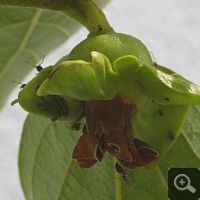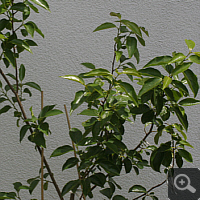Japanese Persimmon (Diospyrus kaki)
Overview
This member of the Ebony family (Ebenaceae) from Asia has very good fruits. However, by these are not meant the under the designation Japanese Persimmon or sharon-fruit in the supermarket offered fruits. Indeed such fruits come from a Japanese Persimmon tree too, but they are special cultivated forms for export. The Italian Japanese Persimmons are distinct larger, flavourful significant better and have rather a consistency of jelly.
Description
Japanese Persimmon trees are deciduous. In autumn the leaves turn intense red before they are thrown. At that moment the fruits are mostly yet unripe. Concerning size and shape a Japanese Persimmon tree in old age is similar to an apple tree.
Culture
In the meantime exist of the Japanese Persimmon several sorts with partly some different taste. Frost tolerance is stated with up to -15°C. It exists many positive experience reports of in Germany bedded-out specimens. During the first years is a slight winter protection with bamboo mats and fleece advantageous. They fruits should be reaped before temperatures come under -5°C. However, mostly the fruits are unripe at that time. Unripe Japanese Persimmons are adstringent, i.e. they cause an insentient feeling in the mouth. Therefore Japanese Persimmons have to after-ripen within the house. That happens best at a dark, cool and dry place. Ideal is a storage between apples. The ethylene gas, that leaks of these, speeds up maturing. Japanese Persimmons are eatable as soon as they are as soft as pudding. Then Japanese Persimmons are true taste wonders.
Experiences
2010
Initially, the in spring acquired Japanese Persimmon tree pleased me a lot. It acted very well-growing and produced several up to 40 centimetres long branches.
2011
Despite of a good winter protection it was completely frozen to death in winter. In spring I planted a new, greater specimen direct in front of a house wall in the west. I hope that this specimen will survive there with a good winter protection überleben wird.


